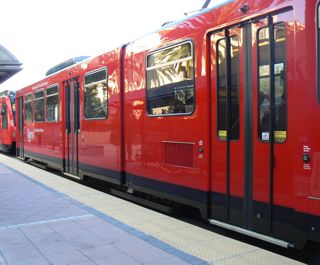When faced with the costs and logistics of rail, planners and city officials increasingly seem to favor Bus Rapid Transit (BRT), a trend likely to continue through the current recession. But even with the many persuasive arguments for BRT, the nagging question remains: why not rail?
When faced with the costs and logistics of rail, planners and city officials increasingly seem to favor Bus Rapid Transit (BRT), a trend likely to continue through the current recession. But even with the many persuasive arguments for BRT, the nagging question remains: why not rail?
 To be successful, a rapid transit system needs to be comprehensive. Either a city is going to invest in comprehensive BRT (like Brisbane or Bogota), a comprehensive rail network (like Toronto, New York, or European metropolitan rail systems), or a mix of rail and BRT. The halfway approach doesn't do the job.
To be successful, a rapid transit system needs to be comprehensive. Either a city is going to invest in comprehensive BRT (like Brisbane or Bogota), a comprehensive rail network (like Toronto, New York, or European metropolitan rail systems), or a mix of rail and BRT. The halfway approach doesn't do the job.
The limited experiments with BRT in the United States have so far amounted to "light rail lite": single corridor bus lines that attempt to mimic light rail. Transportation experts Alan Hoffman and Alasdair Cain argue that significant infrastructure investments - in the form of separated guideways called ‘Quickways' - are needed before American cities can achieve the ridership and efficiency of the world's best BRT.
Similarly, light rail ridership suffers because established networks do not yet cover enough ground. In southern California, the Los Angeles Metro and the San Diego Trolley do not reach most residential neighborhoods, tourist destinations or satellite cities, let alone suburban job centers. (The good news is that these systems are expanding, albeit slowly). Rail stops can also be located in disconnected, unwalkable areas.
If a city is serious about mass transit, it will require substantial capital and a fairly bold vision to implement either BRT or rail (light rail or the uber-expensive heavy rail subway). The most persuasive argument for Bus Rapid Transit is that it can be established more quickly and at lower cost. BRT can also use existing automobile infrastructure like wide roads and freeways. Furthermore, because buses are more flexible than fixed rail, they can leave the busway to access out-of-the way housing developments and office parks. In other words, BRT better serves sprawl, which after all is what shapes most American metropolitan areas.
Still, for riders, skepticism about BRT persists. Will it be as sleek and comfortable as a train? Can one read on a bus, even a modern one? Is the experience a vast improvement over a bumpy city bus? Will it be slowed by car traffic? Given the infrastructure required for true BRT, why not simply pursue rail? Elevated busways can look a lot like freeways – how will they affect neighborhoods?
If a modern rail system seems impossible, Toronto presents a good case for investment in higher quality rail, even if that means diverting funds from other modes (i.e., roads and highways). The city opened its first subway in 1954, added two more lines, integrated subways with retained streetcar lines, and more recently supplemented with above-ground light rail. It is not a coincidence that subways were expanded as several freeway projects were canceled.
So, transit riders and planners, for your city would you choose rail, BRT or a combination of both?

Planetizen Federal Action Tracker
A weekly monitor of how Trump’s orders and actions are impacting planners and planning in America.

Chicago’s Ghost Rails
Just beneath the surface of the modern city lie the remnants of its expansive early 20th-century streetcar system.

Amtrak Cutting Jobs, Funding to High-Speed Rail
The agency plans to cut 10 percent of its workforce and has confirmed it will not fund new high-speed rail projects.

Ohio Forces Data Centers to Prepay for Power
Utilities are calling on states to hold data center operators responsible for new energy demands to prevent leaving consumers on the hook for their bills.

MARTA CEO Steps Down Amid Citizenship Concerns
MARTA’s board announced Thursday that its chief, who is from Canada, is resigning due to questions about his immigration status.

Silicon Valley ‘Bike Superhighway’ Awarded $14M State Grant
A Caltrans grant brings the 10-mile Central Bikeway project connecting Santa Clara and East San Jose closer to fruition.
Urban Design for Planners 1: Software Tools
This six-course series explores essential urban design concepts using open source software and equips planners with the tools they need to participate fully in the urban design process.
Planning for Universal Design
Learn the tools for implementing Universal Design in planning regulations.
Caltrans
City of Fort Worth
Mpact (founded as Rail~Volution)
City of Camden Redevelopment Agency
City of Astoria
City of Portland
City of Laramie




























